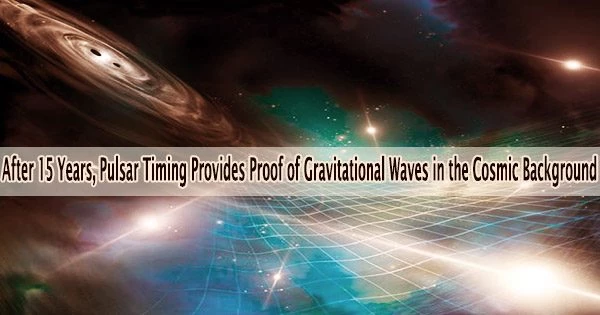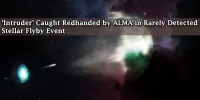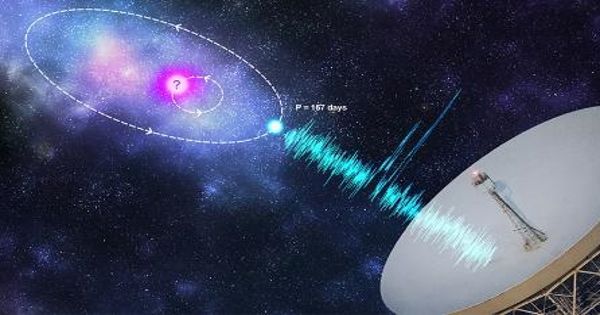Gravitational radiation, a very low-frequency rumbling that rhythmically expands and compresses space-time and the matter contained within it, is buzzing across the universe.
In June, a number of research teams from around the world released a flurry of journal articles detailing more than 15 years of studies of millisecond pulsars in our region of the Milky Way galaxy.
At least one group the North American Nanohertz Observatory for Gravitational Waves (NANOGrav) collaboration has found compelling evidence that the precise rhythms of these pulsars are affected by the stretching and squeezing of spacetime by these long-wavelength gravitational waves.
“This is key evidence for gravitational waves at very low frequencies,” says Vanderbilt University’s Stephen Taylor, who co-led the search and is the current chair of the collaboration. “After years of work, NANOGrav is opening an entirely new window on the gravitational-wave universe.”
In 2015, the Laser Interferometer Gravitational-Wave Observatory (LIGO) discovered gravitational waves for the first time. Smaller black holes or neutron stars, each weighing less than a few hundred solar masses, occasionally merged to create the short-wavelength disturbances in spacetime.
The question now is: Are the long-wavelength gravitational waves with periods from years to decades also produced by black holes?
In one paper from the NANOGrav consortium, published in The Astrophysical Journal Letters, University of California, Berkeley, physicist Luke Zoltan Kelley and the NANOGrav team argued that the hum is likely produced by hundreds of thousands of pairs of supermassive black holes each weighing billions of times the mass of our sun that over the history of the universe have gotten close enough to one another to merge.
In order to match the expected gravitational wave signatures with the most recent discoveries from NANOGrav, the scientists created simulations of supermassive black hole binary communities with billions of sources.
Similar to how waltzing dancers rhythmically vibrate a dance floor, the orbital dance of the black holes before they merge causes spacetime to vibrate. Gravitational waves created by such mergers during the universe’s 13.8 billion year history combine now to create the ambient hum. They resemble the ripples left by a handful of pebbles dropped into a pond.
Since the gravitational wave wavelengths are measured in terms of light years, it took a galaxy-sized array of antennas and a collection of millisecond pulsars to detect them.
This is key evidence for gravitational waves at very low frequencies. After years of work, NANOGrav is opening an entirely new window on the gravitational-wave universe.
Stephen Taylor
“I guess the elephant in the room is we’re still not 100% sure that it’s produced by supermassive black hole binaries. That is definitely our best guess, and it’s fully consistent with the data, but we’re not positive,” said Kelley, UC Berkeley assistant adjunct professor of astronomy. “If it is binaries, then that’s the first time that we’ve actually confirmed that supermassive black hole binaries exist, which has been a huge puzzle for more than 50 years now.”
“The signal we’re seeing is from a cosmological population over space and over time, in 3D. A collection of many, many of these binaries collectively give us this background,” said astrophysicist Chung-Pei Ma, the Judy Chandler Webb Professor in the Physical Sciences in the departments of astronomy and physics at UC Berkeley and a member of the NANOGrav collaboration.
While astronomers have identified several potential supermassive black hole binaries using radio, optical, and X-ray observations, Ma pointed out that they can use gravitational waves as a new signal to direct them where in the sky to look for electromagnetic waves and carry out in-depth analyses of black hole binaries.
Ma is the project leader for a study of 100 of the nearest supermassive black holes to Earth, and he is keen to identify signs of activity near one of them that might indicate a binary pair so that NANOGrav can adjust the pulsar timing array to search for gravitational waves in that region of the sky. Supermassive black hole binaries likely emit gravitational waves for a couple of million years before they merge.
Dark matter axions, cosmic strings, and so-called primordial black holes are some more hypotheses for the origins of the background gravitational waves. Another NANOGrav paper appearing in ApJ Letters lays out constraints on these theories.
“Other groups have suggested that this comes from cosmic inflation or cosmic strings or other kinds of new physical processes which themselves are very exciting, but we think binaries are much more likely. To really be able to definitively say that this is coming from binaries, however, what we have to do is measure how much the gravitational wave signal varies across the sky. Binaries should produce far larger variations than alternative sources,” Kelley said.
“Now is really when the serious work and the excitement get started as we continue to build sensitivity. As we continue to make better measurements, our constraints on the supermassive black hole binary populations are just rapidly going to get better and better.”
Galaxy mergers lead to black hole mergers
Most huge galaxies are expected to have massive black holes at their centers, yet they’re hard to detect since the light they emit ranging from X-rays to radio waves created when stars and gas fall into the black hole is often covered by surrounding gas and dust.
Ma recently analyzed the motion of stars around the center of one large galaxy, M87, and refined estimates of its mass 5.37 billion times the mass of the sun even though the black hole itself is totally obscured.
Tantalizingly, the supermassive black hole at the center of M87 could be a binary black hole. But no one knows for sure.
“My question for M87, or even our galactic center, Sagittarius A*, is: Can you hide a second black hole near the main black hole we’ve been studying? And I think currently no one can rule that out,” Ma said. “The smoking gun for this detection of gravitational waves being from binary supermassive black holes would have to come from future studies, where we hope to be able to see continuous wave detections from single binary sources.”
Since the central black holes of two merging galaxies should sink together toward the center of the bigger merged galaxy, simulations of galaxy mergers imply that twin supermassive black holes are frequent.
“These black holes would begin to orbit one another, though the waves that NANOGrav can detect are only emitted when they get very close,” Kelley said something like 10 to 100 times the diameter of our solar system, or 1,000 to 10,000 times the Earth-sun distance, which is 93 million miles.
But can interactions with gas and dust in the merged galaxy make the black holes spiral inward to get that close, making a merger inevitable?
“This has kind of been the biggest uncertainty in supermassive black hole binaries: How do you get them from just after galaxy merger down to where they’re actually coalescing,” Kelley said. “Galaxy mergers bring the two supermassive black holes together to about a kiloparsec or so a distance of 3,200 light years, roughly the size of the nucleus of a galaxy. But they need to get down to five or six orders of magnitude smaller separations before they can actually produce gravitational waves.”
“It could be that the two could just be stalled,” Ma noted. “We call that the last parsec problem. If you had no other channel to shrink them, then we would not expect to see gravitational waves.”
But the NANOGrav data suggest that most supermassive black hole binaries don’t stall.
“The amplitude of the gravitational waves that we’re seeing suggests that mergers are pretty effective, which means that a large fraction of supermassive black hole binaries are able to go from these large galaxy merger scales down to the very, very small subparsec scales,” Kelley said.
Thanks to the presence of millisecond pulsars, rapidly revolving neutron stars that sweep a brilliant beam of radio waves over Earth several hundred times per second, NANOGrav was able to monitor the background gravitational waves. For unknown reasons, their pulsation rate is precise to within tenths of milliseconds.
When the late UC Berkeley astronomer Donald Backer found the first such millisecond pulsar in 1982, he quickly realized that these precision flashers could be used to detect the spacetime fluctuations produced by gravitational waves. He coined the term “pulsar timing array” to describe a set of pulsars scattered around us in the galaxy that could be used as a detector.
In 2007, Backer was one of the founders of NANOGrav, a collaboration that now involves more than 190 scientists from the U.S. and Canada. A group of millisecond pulsars in our region of the Milky Way galaxy were to be monitored at least once per month, and after adjusting for motion, it was intended to look for correlated changes in pulse rates that could be attributed to long-wavelength gravitational waves passing through the galaxy. The change in arrival time of a particular pulsar signal would be on the order of a millionth of a second, Kelley said.
“It’s only the statistically coherent variations that really are the hallmark of gravitational waves,” he said. “You see variations on millisecond, tens of millisecond scales all the time. That’s just due to noise processes. But you need to dig deep down through that and look at these correlations to pick up signals that have amplitudes of about 100 nanoseconds or so.”
The NANOGrav collaboration monitored 68 pulsars in all, some for 15 years, and employed 67 in the current analysis. The group publicly released their analysis programs, which are being used by groups in Europe (European Pulsar Timing Array), Australia (Parkes Pulsar Timing Array) and China (Chinese Pulsar Timing Array) to correlate signals from different, though sometimes overlapping, sets of pulsars than used by NANOGrav.
The NANOGrav data allow several other inferences about the population of supermassive black hole binary mergers over the history of the universe, Kelley said. For starters, the signal’s amplitude suggests that the population is biased toward greater masses.
Many of the black holes that formed the background may have been larger, possibly even 40 or 60 billion sun masses in size, whereas known supermassive black holes have a maximum mass of roughly 20 billion solar masses. Alternatively, there may just be many more supermassive black hole binaries than we think.
“While the observed amplitude of the gravitational wave signal is broadly consistent with our expectations, it’s definitely a bit on the high side,” he said. “So we need to have some combination of relatively massive supermassive black holes, a very high occurrence rate of those black holes, and they probably need to be able to coalesce quite effectively to be able to produce these amplitudes that we see. Or maybe it’s more like the masses are 20% larger than we thought, but also they merge twice as effectively, or some combination of parameters.”
The NANOGrav team anticipates getting more persuasive evidence for a cosmic gravitational wave background and what’s causing it, which might be a variety of sources, when more data from more years of observations come in. For now, astronomers are excited about the prospects for gravitational wave astronomy.
“This is very exciting as a new tool,” Ma said. “This opens up a completely new window for supermassive black hole studies.”
NANOGrav’s data came from 15 years of observations by the Arecibo Observatory in Puerto Rico, a facility that collapsed and became unusable in 2020; the Green Bank Telescope in West Virginia; and the Very Large Array in New Mexico. Future NANOGrav results will incorporate data from the Canadian Hydrogen Intensity Mapping Experiment (CHIME) radio telescope, which was added to the project in 2019.
















